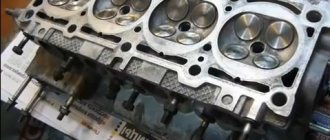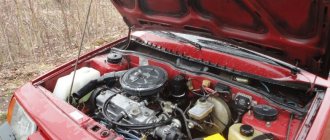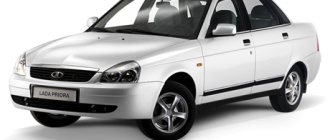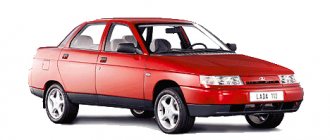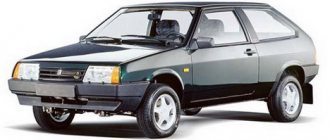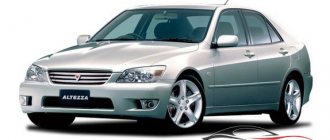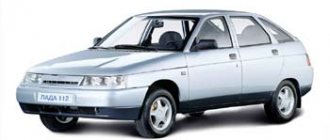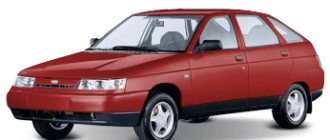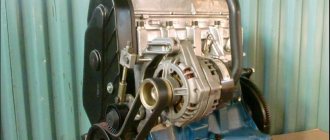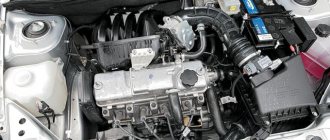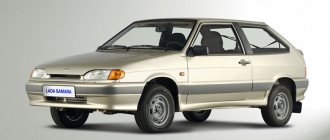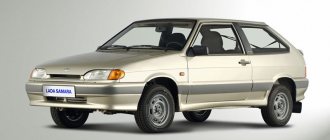VAZ 21099 is one of the most successful and popular models of the Volzhsky Automobile Plant, which went on sale in 1990 and was able to stay on the assembly line until 2011. This car, also well known under the name LADA Samara, received reliable power units that provided the necessary dynamics and excellent fuel efficiency. The VAZ 21099 engine was equipped, depending on the specific modification, with a carburetor and an injector, which made it possible to extract 73 horsepower from a volume of 1.5 liters.
Specifications
The VAZ 21099 engine has the following technical characteristics:
Download .xls file
xls
Download picture
Send by email
| OPTIONS | VALUES |
| Years of manufacture | 1990 - 2011 |
| Weight | N. d |
| Cylinder block material | cast iron |
| Motor power system | carburetor |
| Type of cylinder arrangement | In a row |
| Engine displacement | 1.5 liters |
| Engine power | 73 l. With. |
| Number of cylinders | Four |
| Number of valves | Two |
| Piston stroke | 71 millimeters |
| Cylinder diameter | 82 millimeters |
| Compression ratio | 9.8 |
| Torque Nm/rpm | 106 /360 |
| Environmental standards | EURO 2 |
| Fuel | petrol |
| Fuel consumption | 7.8/100 km |
| Oil | 5W-30 |
| Oil volume in crankcase | 3.5 liters |
| When replacing, pour | 3.2 liters |
| Oil change is carried out | every 15 thousand km |
| Motor life | |
| - according to the plant | 125 |
| - on practice | 250 |
The following models are equipped with this motor: 21083, 21093, 21099, 21111, 2115.
Body dimensions of Lada Samara
The length of the Lada Samara body for all modifications ranges from 4006 (mm) to 4205 (mm).
Body parameters for standard modifications:
Lada Samara VAZ-2108:
- Length: 4006 (mm);
- Width: 1650 (mm);
- Height: 1402 (mm);
- Wheelbase: 2460 (mm);
Lada Samara VAZ-2109:
- Length: 4006 (mm);
- Width: 1750 (mm);
- Height: 1402 (mm);
- Wheelbase: 2460 (mm);
Lada Samara VAZ-21099:
- Length: 4205 (mm);
- Width: 1650 (mm);
- Height: 1402 (mm);
- Wheelbase: 2460 (mm);
- Ground clearance: 160 (mm).
Body characteristics:
The main characteristics of the car body include: wheelbase, ground clearance (ground clearance), overall width and overall length.
For some cars, the wheelbase may be different for the right and left wheels (the difference can be several tens of millimeters), this is due to the design features of the model and does not negatively affect the driving performance of the vehicle.
Features of ground clearance measurement:
When determining the ground clearance of a model, the central part is understood to be a rectangle, the length of which is equal to the length of the car, and the width is limited by two straight lines spaced 100 (mm) from the inner surface of the wheels.
Important: in some cases, the value of the vehicle's wheelbase may change slightly when operating certain types of independent suspension, for example, with trailing arms.
Other names:
Other designations for the Lada Samara hatchback on the Russian market: VAZ 2108, VAZ 2109, VAZ 2113, VAZ 2114.
Years of production years of production of all modifications of the model: 1984-2013.
Description
Three power units were installed on the VAZ 21099. The four-cylinder 1.3 liter engine with a power of 64 horsepower was not in great demand among car owners, since its power was not enough for such a car.
Buyers were also offered two options for 1.5-liter gasoline engines, which differed in the intake manifold and power system.
Depending on the specific modification, it was possible to remove 73 and 79 horsepower from this engine. Note that the most popular was the carburetor engine, which had a power of 73 hp. s, was distinguished by reliability, fuel efficiency and ease of maintenance.
This modification of the power units was built on the basis of the VAZ 21083 engine. This is an eight-valve engine that used a carburetor power system and had an overhead camshaft. This power unit is made with a cast-iron cylinder block, and thanks to the installation of a carburetor power system, it is easy to operate and easy to repair.
In fact, it was a classic version of the engine, which was installed on the seventh and eighth VAZ models. This engine had a belt drive, which improved its reliability. At the same time, the service work to replace the timing belt was not particularly difficult, so every car owner could carry out such repairs. The timing belt and all rollers are replaced every fifty thousand kilometers.
This engine, provided it was timely and competently maintained, was reliable and had a service life of about 150 thousand kilometers. In practice, the mileage before major repairs could be even 250,000 kilometers.
Servicing this power unit was not difficult. The oil was changed at a mileage of 15 thousand kilometers. This unit did not require any more serious service work.
The only caveat was that it required the use of high-octane fuel. This engine was originally designed to run on 93 gasoline. But attempts to save on fuel and use 76 gasoline led to various kinds of serious damage.
The power indicator is 73 hp. s, while such power figures are achieved at a high 5600 engine rpm. It should be said that thanks to the front-wheel drive layout, the VAZ 21099 shows good dynamics with this engine and is economical. Fuel consumption in mixed mode was 7.8 liters per hundred kilometers.
Service
Maintenance of VAZ-99 engines is carried out in the same way for both injection and carburetor versions. The service interval is 10,000 km. Every maintenance it is necessary to change the oil and filter element. As for other operations, it is worth replacing the air filter every 20-25 thousand km, as well as adjusting the valves.
Every 40,000 km it is necessary to change the gas distribution mechanism drive. In addition, after such a mileage, it is recommended to replace the spark plugs and diagnose the condition of the high-voltage wires.
It is worth checking the condition of the water pump, as well as the drive belt of auxiliary components. Particular attention is paid to the presence of leaks in the power unit. Most often they form under the valve cover - this means it's time to change the gasket.
Every 50,000 km of the VAZ-99 injection version, it is necessary to change the fuel filter and also check the condition of the injectors. As practice shows, it is during this period that they begin to clog and create discomfort for the owner. They can be cleaned and, as a last resort, replaced.
Malfunctions
| FAULT | CAUSES AND REMEDIES |
| The appearance of a pronounced knocking of valves when the gas pedal is sharply pressed. | The reason for this is improper operation of the carburetor, the use of low-quality low-octane gasoline, or incorrectly set valve clearances. In the latter case, the repair consists of opening the valve cover and adjusting the valves. |
| A warning signal indicating insufficient oil pressure appears on the dashboard. | The weak point of these engines was the oil filters, which often broke, causing the engine to lose oil. As a result, the insufficient pressure sensor was triggered. Repair consists of identifying the location of the leak and replacing leaky seals. |
| The motor runs with obvious interruptions. | These modifications of the power unit were equipped with Solex carburetors, which were not particularly reliable, which led to problems in the operation of the engine. The repair consisted of replacing the carburetor with an improved modification. |
| Engine cooling problems. | The cooling system used was also not reliable, which led to regular breakdowns of the pump and thermostat. To eliminate such problems, it was necessary to change the thermostat or open the engine and replace the failed cooling system pump. |
Review of the Soviet and Russian automobile industry of the 80s - 90s of the twentieth century
The rapid economic growth that began in the 60s of the last century led to a sharp jump in the domestic automobile industry, which resulted in very good for its time:
- GAZ-21;
- Moskvich-412;
- Gull;
- ZAZ-965 A (Zaporozhets).
But by the beginning of the 70s, most of the models turned out to be outdated and therefore unsuitable for the foreign market. Nevertheless, the residents of the Union purchased them (if possible), because there was no alternative to them. Therefore, by the beginning of the eighties, even the new models that replaced the cars of previous decades no longer met the new requirements, which means that a new car was required, suitable for the foreign and domestic markets.
Tuning
This power unit allows you to increase power to 90-95 horsepower without loss of engine life. Engine tuning could be done by replacing the carburetor with a direct injection system, as well as by installing new lightweight flywheels and crankshafts. The VAZ 21099 engine with an injector produced about 90 horsepower.
There are also options for tuning the VAZ 21099 engine, which involve installing a turbine and supercharger on the power unit. It should be said that the installation of turbines made it possible to obtain a significant increase in power, but the service life of such an engine is significantly reduced. As a result, car owners had to carry out complex overhauls every 70-90 thousand kilometers.
How much can a VAZ 21099 weigh?
The total weight of the vehicle during operation is 1 ton 340 kg. The front suspension is independent with shock absorbers, coil springs, lower trailing arms with braces and longitudinal stability adjusters (McFerson). The rear suspension is on transverse correlation arms, with cylinder springs and hydraulic shock absorbers.
The front brake configuration is disc, the rear brakes are drum, with automatic clearance adjustment. Drive – hydraulic, 2-circuit, diagonal, with a vacuum booster and brake booster stabilizer. The “handbrake” is for the brake devices of the rear chassis, the drive is a cable drive.
As a result, an improved modernization of Lada of the eighth and ninth models is presented for you. With all the attendant improvements and an extended rear end. In general, the car is still used by most car enthusiasts as the most modernized brand from the entire VAZ line.
Installation of gas equipment
HBO by car
Installation of LPG on a VAZ is possible due to the presence of injectors. Some people install gas equipment without thinking about whether it is really necessary. In fact, HBO is a wonderful addition for VAZ, but it also has its drawbacks.
Installing an LPG does not make sense if the driver does not travel very far, because the main advantage of this equipment is savings when traveling long distances. For example, if a car travels 100 km a day, then installing LPG will reduce fuel costs by almost 2 times, but if the mileage is 20 km a day, then there will not be much savings.
The main disadvantages of HBO for the car and its owner are the following:
- loss of dynamics;
- decent cost of equipment installation;
- complication of the fuel supply system (as a result - more breakdowns);
- weighting the car.
However, it is necessary to note some advantages of HBO.
- Reducing the likelihood of detonation. No matter how strange it may sound, it is true. Gasoline is more likely to ignite than gas.
- Less harmful emissions.
If after installing the LPG the car jerks strongly, contact a specialist immediately! This behavior of the car can be a sign of many serious problems.
Salon
Today, no one can be surprised by a high panel. But if you remember those times, then all car enthusiasts were divided into two camps. Some liked the high panel, while others enthusiastically accepted the VAZ 21099, which had a low panel. The instrumentation in early versions was modest, but after some time the developers increased the size of the panel. It became more capacious, and it was possible to place acoustics on it. With this new product, there are fewer squeaks in the cabin. All owners noted this.
